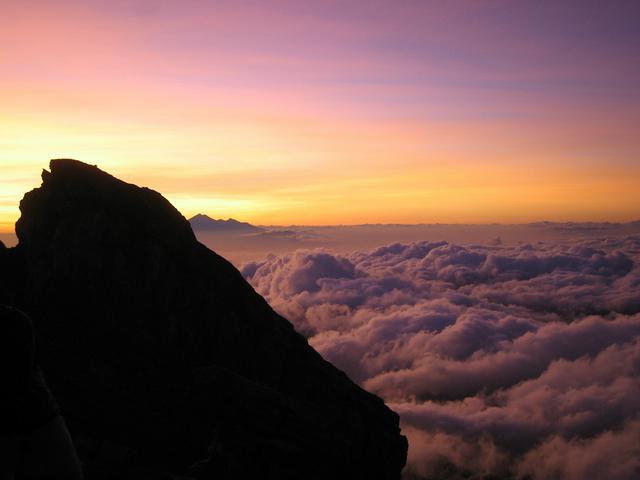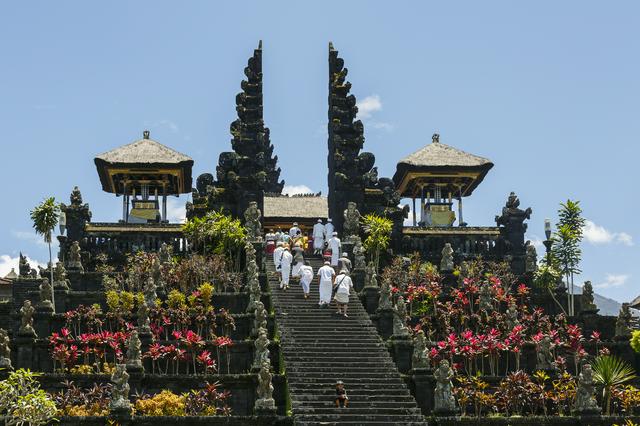
Mount Agung (Gunung Agung) is an active volcano in East Bali, Indonesia.
Towering 3,142 m above sea level, Gunung Agung, meaning "Greatest Mountain", is the highest mountain on the island of Bali and the fifth highest volcano in Indonesia.
Mount Agung has huge spiritual significance to the people of the island, and is home to the 'Mother Temple' of Besakih. It forms part of a chain of volcanoes that make up the backbone of Bali.
Balinese legend has it that Agung was created when the Hindu God Pasupati split Mount Meru (the spiritual axis of the universe) and formed Mount Agung with a fragment.
Mount Agung has been erupting in 2017–2019. Its 1963 eruption was one of the largest 20th century eruptions anywhere in the world (see information box in this article). Historical eruptions of the volcano are poorly recorded, but there was certainly one in the 1820s.
At lower elevations the mountain is covered in lush forest, but this soon gives way to a desolate landscape of barren volcanic rock and ash scree. From the peak of Mount Agung the views are extraordinary in all directions, but perhaps most dramatic to the east where the sun rises above Mount Rinjani on Lombok.
Wild pigs and macaques abound on the forested slopes of Mount Agung. Birdlife is impressive including frequent sightings of hawks and eagles, but is not as obvious and easy to observe as in the West Bali National Park.
Mount Agung dominates the surrounding area influencing the climate. The clouds come from the west and Agung takes their water so that the west is lush and green and the east dry and barren.
The best time to climb Mount Agung is in the dry season of April to October. January and February should certainly be avoided if possible due to heavy rain, possible flooding and even landslides in the area.
At lower elevations it remains tropical but becomes distinctly cold and often very windy on the high bare rock slopes.
Mount Agung is viewed as sacred and for that reason is off limits to climbers during important ceremonies. Your guide will know and will also be able to obtain any necessary permissions from temple administrators for which some nominal donation may be required.
Guide fees may vary between about Rp 400,000 and Rp 1,000,000 depending on how you arrange the guide, the route taken and the level of English expected. Generally it is possible to put all arrangements in place once you reach Bali, but for peace of mind you might want to make contact with guides before you leave home. Some guides speak far better English than others.
Pura Pasar Agung is one of Bali's nine directional temples and it sits at the start point of one of the ascent routes up Mount Agung. It is close to the village of Selat on the main road from Rendang to Karangasem.
The Sidemen/Selat area is stunningly beautiful. It incorporates several valleys in the foothills of Mount Agung on the route between Karangasem and Rendang. The drive through this area is most scenic and one of the very best in Bali. Stunning rice terraces, lush forested hill-sides and the mountain itself, all combine to make this a magical area to visit. If you stop in the village of Selat it is easy to find local guides for undemanding hikes in the area.
Besakih is known as the Mother Temple of Bali. Besides being the most important temple for the whole of the island, another attraction of Besakih, actually a complex of temples, is its dramatic location on the southern slopes of Mount Agung.

- Besakih Temple. The temple complex in the village of Besakih, about 1,000 m up the slope of Mount Agung, is the holiest in Bali. It consists of 23 temples. The biggest, not surprisingly, has the word "agung" ("greatest") in its name and is called “Pura Penataran Agung”. The temple has six tiers, built as terraces.
Like most major temples in Bali, the area surrounding Besakih is starting to take the shape of a small town, with many souvenir and eating shops. It can get overrun by quite aggressive touts and souvenir peddlers. As you leave the parking area, you will be stopped at a post and asked to make a donation and assigned a guide. This is on top of your official Rp 60,000 entry fee. The donation book will show many people donating huge amounts but please bear in mind that it is easy to scribble names and numbers with lots of zeros. The people collecting the donation can be quite pushy and will not think twice about asking for more money. You could try refusing to pay or suggest Rp 20,000 as your "first offer". While you may dislike guides, one may be quite useful as he will give a good explanation of Balinese Hinduism and the various temples of Besakih. He can also show you how to pray (it does not matter what religion you follow) if you so wish. Your "donation" covers the cost of a guide.
The temple complex consists of at least 18 separate temples and numerous other shrines. Each temple has a specific purpose, whether it is for the worship of a particular god, for the use of the people of a particular region of Bali, or for the use of a particular caste. The only way to move around the temples of Besakih is on foot. The complex gradually rises up the slopes of Gunung Agung and there are countless flights of steps. Be prepared with a pair of comfortable shoes.
The most important and most impressive temple in the compex is Pura Penetaran Agung, which is built on six different stepped levels. The entrance, approached up a flight of steps, is an impressive split gateway (candi bentar) behind which is the kori agung, or gateway to the middle courtyard (jaba tengah). This is the area where during ceremonies hundreds of worshippers gather in pristine white dress, and create a quite wonderful spiritual sight. Non-Hindu visitors will never be allowed beyond this point into the inner courtyard (jeroan), and access will be restricted even here during special ceremonies. Indeed, many temple areas at Besakih may be off-limits when religious events are being held. There is though always something of interest to see.
Other temples at Besakih include the remaining two equivalents of the three normal local village temples (see Bali Temples). Here though, these perform those functions for the whole of the Bali. The other two are called Pura Basukian and Pura Dalem.
A visit to Besakih is a must-do for any traveler to Bali. It is though not always the easiest experience due to the very pushy souvenir vendors and guide touts. Those visitors who are not used to this type of attention should prepare themselves for a unique and sometimes very irritating trip.
The area around the village of Selat provides a lot of options and local guides.
There is a huge complex of souvenir stalls around the entrance to Besakih.
Bring in ample good food with you for your trek. Sunrise on Mount Agung accompanied by a breakfast of fresh fruit and pastries is to be recommended. Once you start the trek there is nowhere to purchase food.
Once you start the trek there is nowhere to buy water so bring in enough with you. A flask of hot coffee or tea is also a good idea.
No matter your experience, do not attempt to climb Mount Agung without a guide. The routes are difficult to follow and you are likely to get lost. Avoid climbing in the wet season and especially in January and February. You are still in the tropics but Mount Agung is a high peak and the top is often cold and windy so bring appropriate clothing.
Some mild altitude sickness is possible. Understand this condition and be aware of the symptoms. It is important to drink more water than you think you need and to avoid the dehydrating effects of substances such as alcohol and caffeine for 24 hours before your planned ascent. At these elevations though, symptoms should only be minor.
Mount Agung is well connected by road to major tourist centres in Bali. The most obvious places to head to next are Candidasa, Amed and points west to Singaraja and Lovina.
